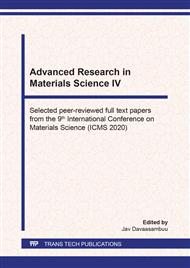[1]
W. Dagula, O. Tegus, B. Fuquan, L. Zhang, P. Z. Si, M. Zhang, W. S. Zhang, E. Brück, F. R. de Boer, and K. H. J. Buschow, Magnetic-Entropy Change in Mn1.1Fe0.9P1-xGex Compounds, IEEE Transactions on Magnetics, 41 (2005) 2778-2780.
DOI: 10.1109/tmag.2005.854774
Google Scholar
[2]
E. Brück, O. Tegus, X.W. Li, F.R. de Boer, and K.H.J. Buschow, Mangetic refrigeration-towards room temperature applications, Physica B, 327 (2003) 431-437.
DOI: 10.1016/s0921-4526(02)01769-6
Google Scholar
[3]
L. Song, G.F. Wang, Z.Q. Ou, O. Haschaolu, O. Tegus, E. Bruck, K.H.J. Buschow, Magnetic properties and magnetocaloric effect of MnFeP0.5Ge0.5-xSix compounds, J Alloys and Compd, 474 (2009) 388.
DOI: 10.1016/j.jallcom.2008.06.098
Google Scholar
[4]
Z.Q. Ou, G.F. Wang, O. Haschaolu, O. Tegus, E. Bruck, K.H.J. Buschow. Magnetic properties and magnetocaloric effects in Mn1.2Fe0.8P1-xGex, J Phys: Condens.Matter, 18 (2006) 11577.
Google Scholar
[5]
N.T. Trung, Z.Q. Ou, T.J. Gortnmulder, O. Tegus, K.H.J. Buschow, and E. Brück, Tunable thermal hysteresis in MnFe(P,Ge) compounds, Appl Phys Lett, 94 (2009) 102513.
DOI: 10.1063/1.3095597
Google Scholar
[6]
V. Provenzano, Alexander J. Shapiro and R.D. Shull, Erratum: Reduction of hysteresis losses in the magnetic refrigerant Gd5Ge2Si3 by the addition of iron, Letters to Nature, 429 (2004) 853.
DOI: 10.1038/nature02657
Google Scholar
[7]
H. Wada, Y. Tanabe, Giant magnetocaloric effect of MnAs1-xSbx, Appl Phys Lett, 79 (2001) 3302.
DOI: 10.1063/1.1419048
Google Scholar
[8]
O. Tegus, E. Brück, K. H. J. Buschow and F. R. de Boer, Transiton-Metal-Based Magnetic Refrigerants for Room-Temperature Applications. Letters to Nature, 415 (2002) 150.
DOI: 10.1038/415150a
Google Scholar
[9]
E. Brück, O. Tegus, X.W. Li, F.R. de Boer, K.H.J. Buschow, Magnetic refrigeration-towards room-temperature applications, Physica B, 327 (2003) 431.
DOI: 10.1016/s0921-4526(02)01769-6
Google Scholar
[10]
F.X. Hu, B.G. Shen, J.R. Sun, X.X. Zhang, Influence of negative lattice expansion and metamagnetic transition on magnetic entropy change in the compound LaFe11.4Si1.6, Appl Phys Lett, 78 (2001) 3675.
DOI: 10.1063/1.1375836
Google Scholar
[11]
A. Fujita, S. Fujieda, Y. Hasegawa, and K. Fukamichi, Itinerant-electron metamagnetic transition and large magnetocaloric effects in La(FexSi1-x)13 compounds and their hydrides. Phys Rev B, 67 (2003) 104416.
DOI: 10.1002/chin.200535243
Google Scholar
[12]
J.H. Huang, L. Song, P.Y. Jin, G.F. Wang, J.R. Liu, H.W. Yan, and J.X. Zhang, Magnetocaloric effect in LaFe11.7-xCo0.78Si1.05Bx alloys, J funct mater 37 (2006)1888.
Google Scholar
[13]
D.M. Wang, L. Song, Y.H. Wang, W. Zhang, L.G. Bi, and O. Tegus, Magnetocaloric effect in MnFeP0.63Ge0.12Bx (x =0, 0.01, 0.02, 0.03) compounds, Acta Metall Sin 47 (2011) 344.
Google Scholar


